Sailing the Greek Islands (Yoga, Hiking and Wine Included)
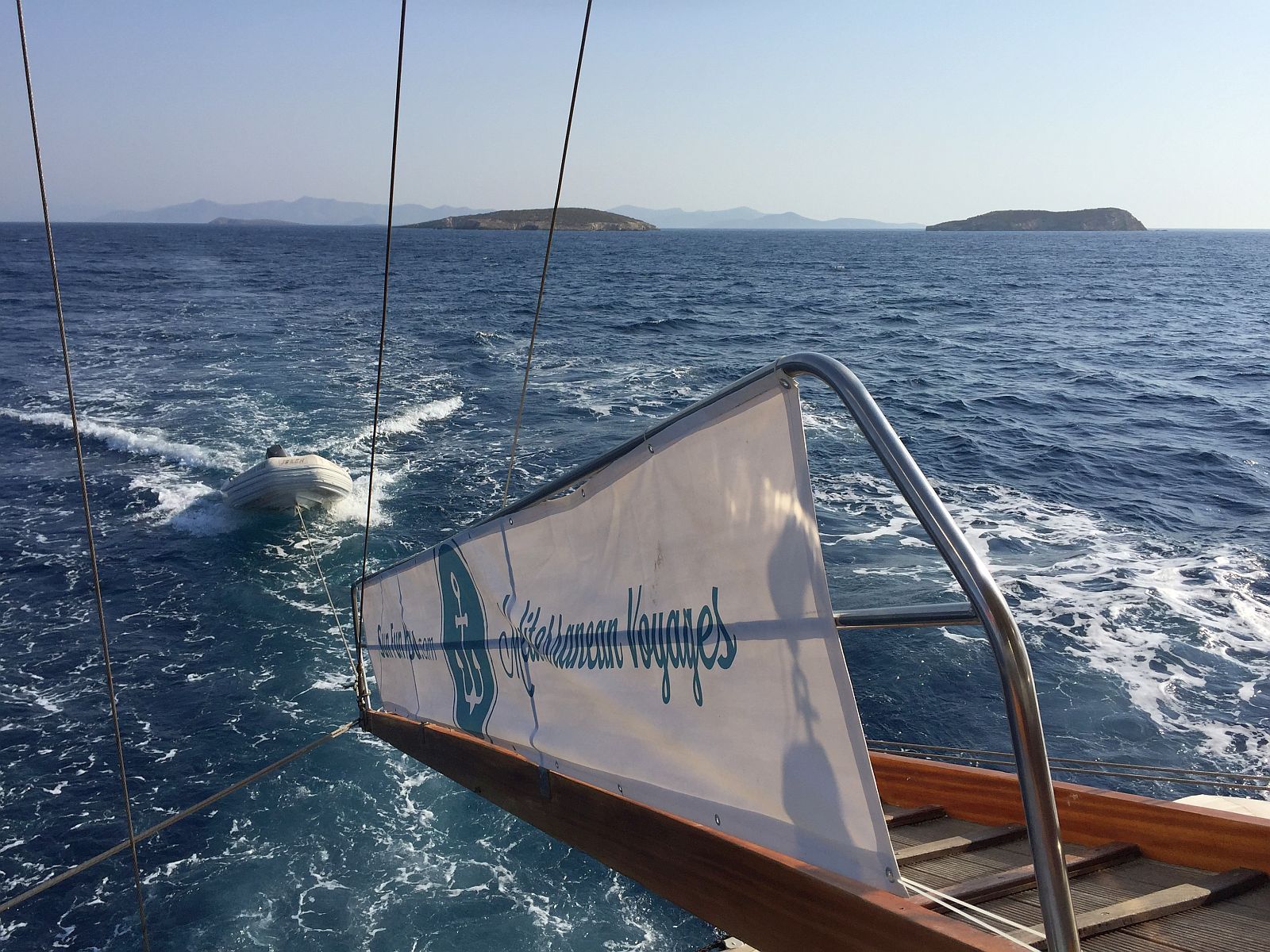
As our boat sailed out of the ancient Greek island harbor of Kos, our group of 10, mostly strangers, sat in a circle around a long, wooden table, studying a map spread out before us depicting the Dodecanese, the group of islands clustered together in the southeastern Aegean Sea. Our tour guide for the trip, Ali, was pointing out the various islands we were to visit over the next week.
“Today will be the longest sail,” he explained in a slow cadence, something we would get used to hearing after breakfast every morning as he announced the forthcoming day’s itinerary. “We are heading north to Patmos. From there we will turn around and visit many islands along the way until we come back to Kos. Of course, we will be doing many hikes and other physical activities along the way.”
My eyes wandered along the names of islands he was pointing to: Pserimos, Kampos, Patmos, Lipsi, Leros, Kalimnos. These were not the names of islands one sees on the cover of glossy brochures luring tourists to the Greek Islands or hears about over holiday dinners from distant relatives when discussing their summer trip.
No, this is officially off-the-beaten-path territory when it comes to the Greek Islands — at least for most tourists. For those who have spent time in the country, partying it up in Mykonos or wandering shoulder-to-shoulder with the crowds through the streets of Santorini, these are the islands one visits to see the other side of Greece. These are the islands where fisherman outnumber tourists on most days, where you’re more likely to run into a stray sheep than a stag party, and where traditions have continued uninterrupted for many millennia. This was the part of Greece I was most excited to see.
After finishing his introduction, Aislyn, our physical trainer for the week, introduced herself. After learning a bit about each of our fitness levels, she then announced that our first workout of the trip would be commencing shortly at the bow of the boat. “Don’t forget to bring your resistance bands that were in your welcome bag when you arrived!”
It goes without saying, this was not going to be your typical Greek island cruise.
It was the middle of September, and we had signed up with Sun Fun You for their active 7-day Greek Islands Voyage trip. The plan was to start from Kos, head north to Patmos, then island-hop south until we arrived back in Kos, sleeping in various coves, ports and docks along the way.
Not one for sitting around idly during my travels (especially on a boat), I was particularly interested in the fact that Sun Fun You places a large emphasis on physical activities. Not only would each day include a morning and afternoon fitness session, but there were also half-day hikes planned for each island we would be visiting. This means rarely a day would go by without some sort of workout to get the juices flowing (and to work off the large amount of feta one tends to consume here).
Our boat for the week, the Muhtesem, was technically a gulet, the term for the two-masted wooden boats typically found in this part of the world. Gulets are known for their ornamental, dark-wood exteriors and long, flat decks. Most are hand-built in nearby Turkey, just as ours was. I later learned our Captain personally oversaw the construction of the particular gulet we were on.
On deck there was a large, flat expanse at the bow where most of the workouts took place, and at the stern was large table used for group meals and which was surrounded by padded seating, perfect for afternoon naps. Below deck were eight cabins with adjoining private bathrooms and a cozy living room/den with a library stocked with Mediterranean-themed books and DVDs (I was inspired to pick up a copy of Zorba the Greek toward the end of the week).
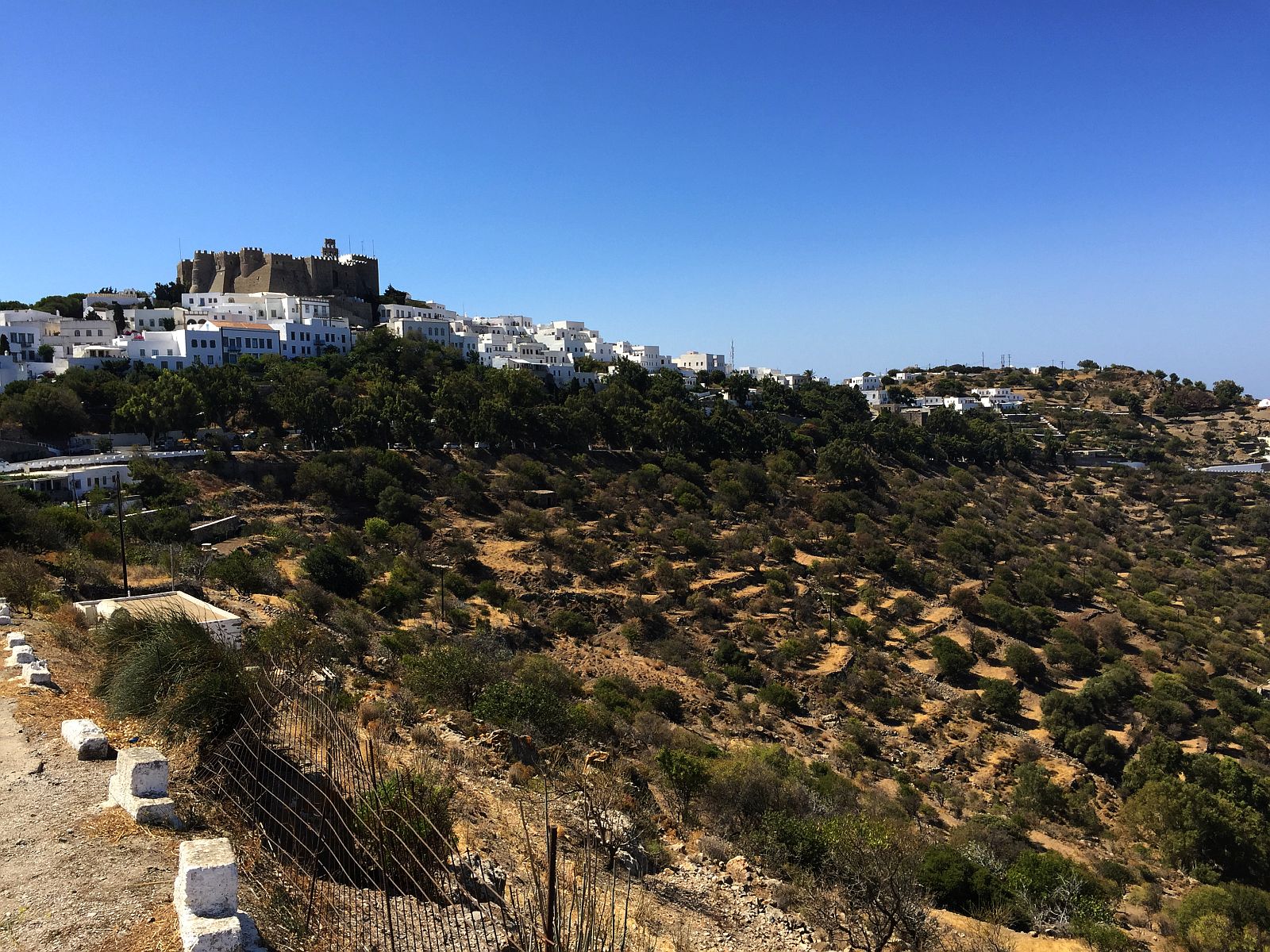
After our first humid night at sea, which resulted in half of the group taking their pillows and blanket outside to sleep, we arrived at our first stop, Patmos. Located on the northern tip of the Dodecanese, the island has a population of less than 3,000 and is well known in the Christian and Greek Orthodox religions as home to the Monastery of Saint John the Divine, the castle-like structure on a hilltop that is a pilgrimage site for many Christians.
After a short walk through the winding backroads of the town of Skala, Ali gathered our group at the base of the hill we would be ascending. “We are going to first visit the Cave of the Apocoloyps, the cave where it is believed John of Patmos — hidden away to avoid the detection of those hunting Christians throughout the region — wrote the Book of Revelation. Then we will head further uphill to the monastery. Please drink lots of water and don’t forget to put on your sunscreen!” Wise words as the early morning sun beat down, baking the parched land surrounding us. Ainslie then led us through a few stretches, and then we were off.
An hour later we arrived at the cave, a welcome respite from the heat due to its location in the side of the hill. After a visit to the austere chapel inside and a short break in the shade, we continued on, heading further uphill until the path ended at a set of large doors belonging to the monastery.
The monastery was initially built in 1088, and with its foreboding walls and numerous turrets, it appears to the naked eye more like a Byzantine castle than a church. Inside, an outdoor courtyard is surrounded by living space and a number of small chapels where the monks used to worship safely far from their prosecutors.
From the courtyard we took one last short walk up a steep staircase to the rooftop where we were treated to a panoramic view of the island below, our boat barely visible in the distance floating in the bay: a speck of brown in a shiny expanse of bright blue.
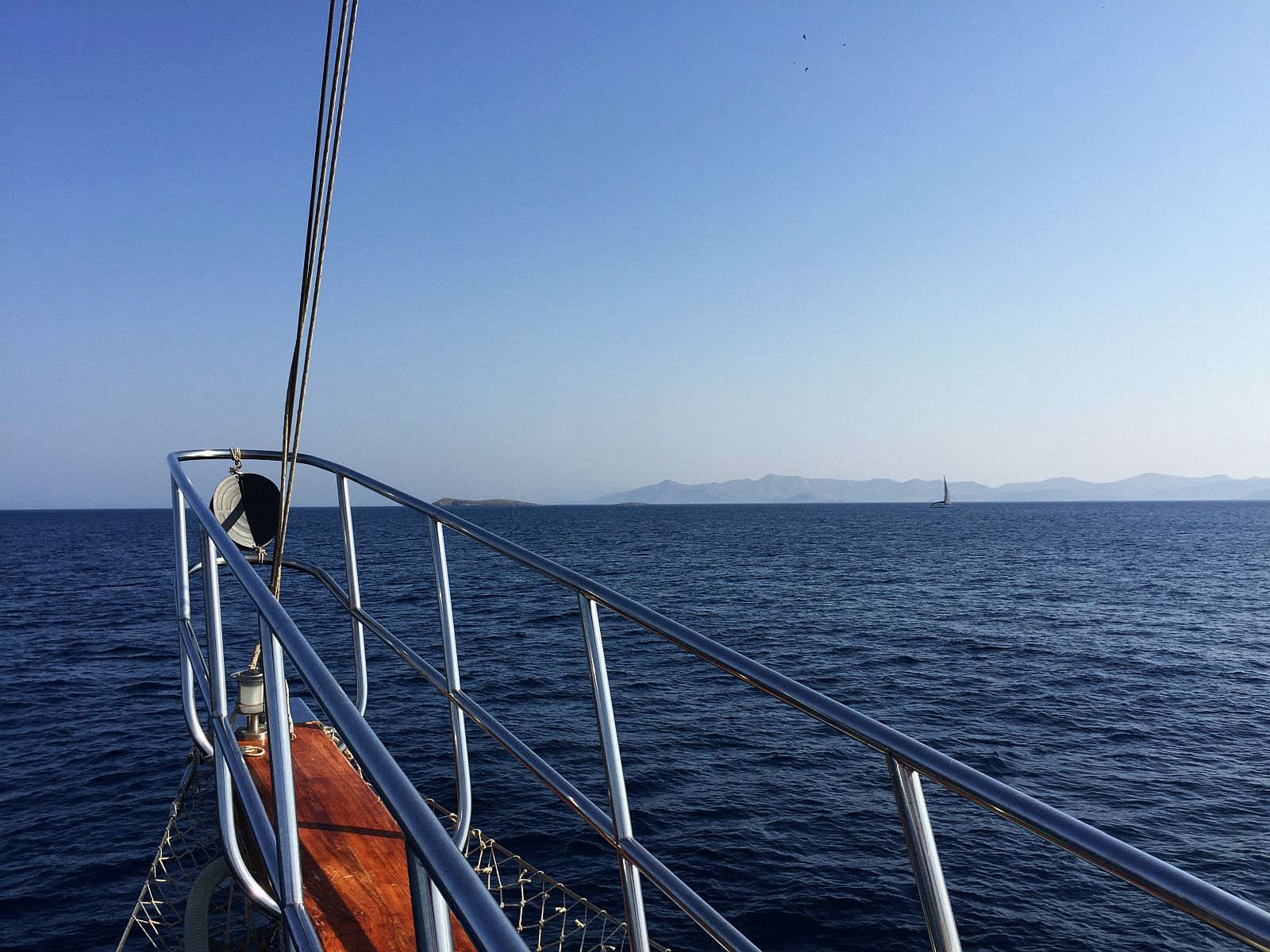
When out on the water, breakfast, lunch and dinner are all eaten family-style. The captain of the ship, with the help of a small crew, does double-duty as chef. Every meal was served with the obligatory Mediterranean accouterments including fresh bread, feta cheese, salad and a selection of olives, followed by our main meal and fresh fruit for dessert. Given the amount of calories each of us were burning each day, the sound of the bell being rung before every meal was usually followed by an ordered stampede of passengers eager to start digging in.
At night, after the table was cleared and drinks were topped off, we would break out a deck of cards, or more frequently, my recently purchased set of Cards Against Humanity, where we would play late into the night under a full set of stars and the sound of waves lapping against the boat’s hull.
One night, after most everyone had gone to sleep, I stayed up late with the boat’s crew drinking cans of Mythos and downing the occasional shot of raki, the anise-flavored liquor popular in this part of the Mediterranean. I asked the captain about the history of the Muhtesem. He explained that he actually owned the boat and helped to oversee its construction which was done using traditional techniques by boat-makers who can trace their trades back generations.
“After many years working as a chef in the kitchens of 5-star hotels, I finally quit my job to pursue my dream,” he explained, his eyes looking around at his prized possession. Later in the trip, I met his young daughter and wife who had come on board to visit, an infrequent event during the summers when he spends most of his time at sea at work in his new profession.
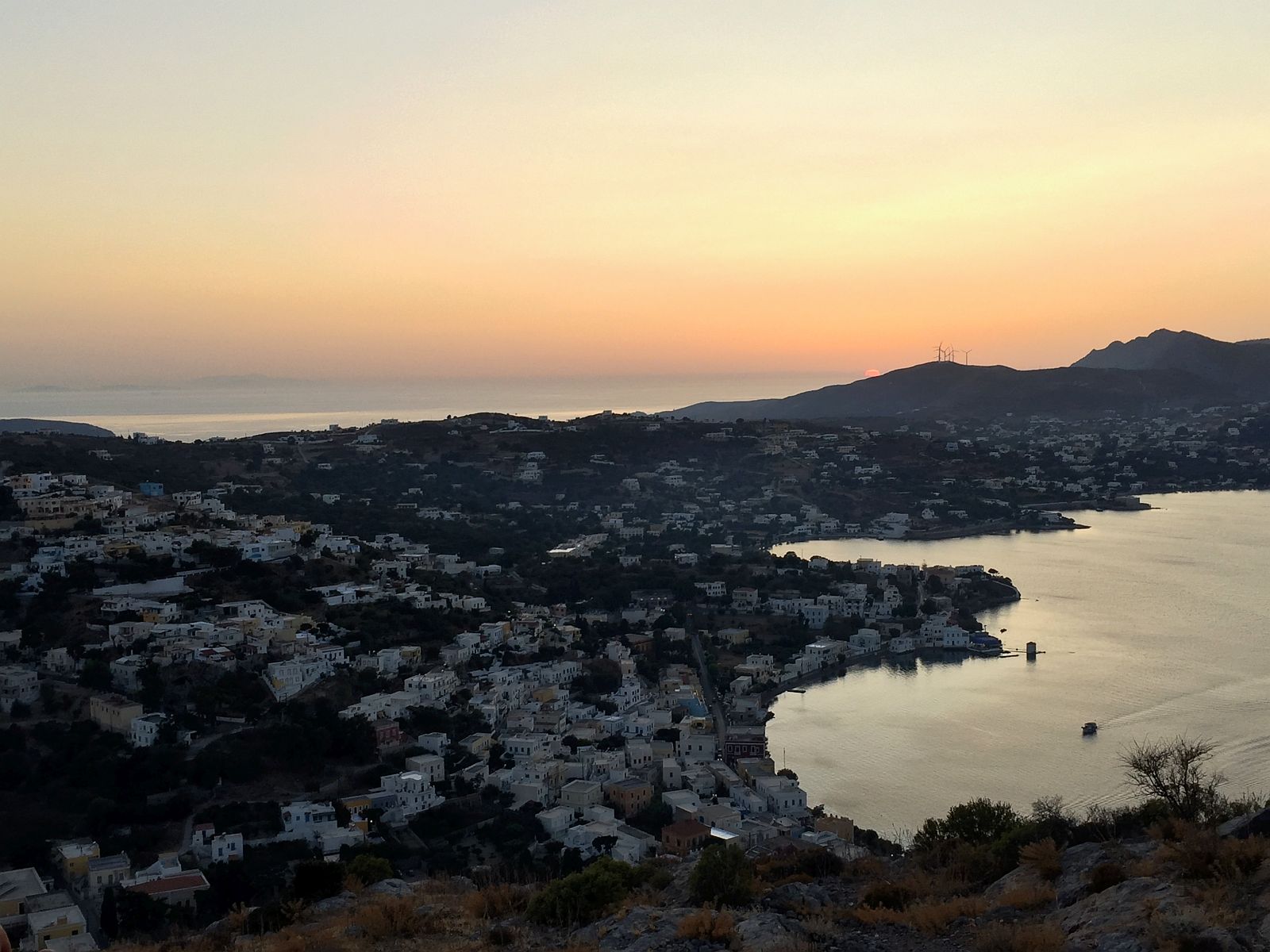
The next day we continued on to the island of Leros where we spent the morning at Aglia Maria Cove swimming, snorkeling along the shallow coastline and enjoying a short break before the sunset hike planned for later in the day. Temperatures for September in this part of Greece hover comfortably around 80 degrees Fahrenheit — a bit warm for sleeping in the cabins, but great for dozing under the stars and swimming. Looking back, I don’t think we saw a single cloud in the sky during the entire week we were there. Clearly, September is an ideal time to visit (we were also told July is a great time to come too; August not so much since it’s the hottest month of the year and uncomfortable during the day for doing much of anything, especially physical activities).
After we finished having fun in the water, we docked in Patneli, an old fishing village home to a small beach and marina, walked along the beach past the coastline cafes and bars, and set out through the windy streets toward the Castle of Pandeli, also known as the Castle of our Lady.
Built in the 10th Century, the castle was donated by the Byzantine Empire to the Monastery of Agios Ioannis Theologos, after which it was taken over by the Knights of Saint John and used to fend off invaders. Today, travelers can visit via an hour-long hike along a switchback road from the town center.
We arrived just in time, and with only minutes to spare before sunset. We quickly rushed around the castle to see the various fortifications that were built over the centuries — obligatory Game of Thrones references were of course made — and then we gathered for our first hilltop sunset in Greece. Known the world over for its sunsets — perhaps most notably for the crowds that gather nightly in Santorini — I can safely report our Leros sunset was just as good, and with the added benefit of having a few thousand fewer people around to share it with. As the sun made its final descent, the small group gathered here on the hilltop began to clap, cheering on the hazy orange and purple light peeking out from the horizon.
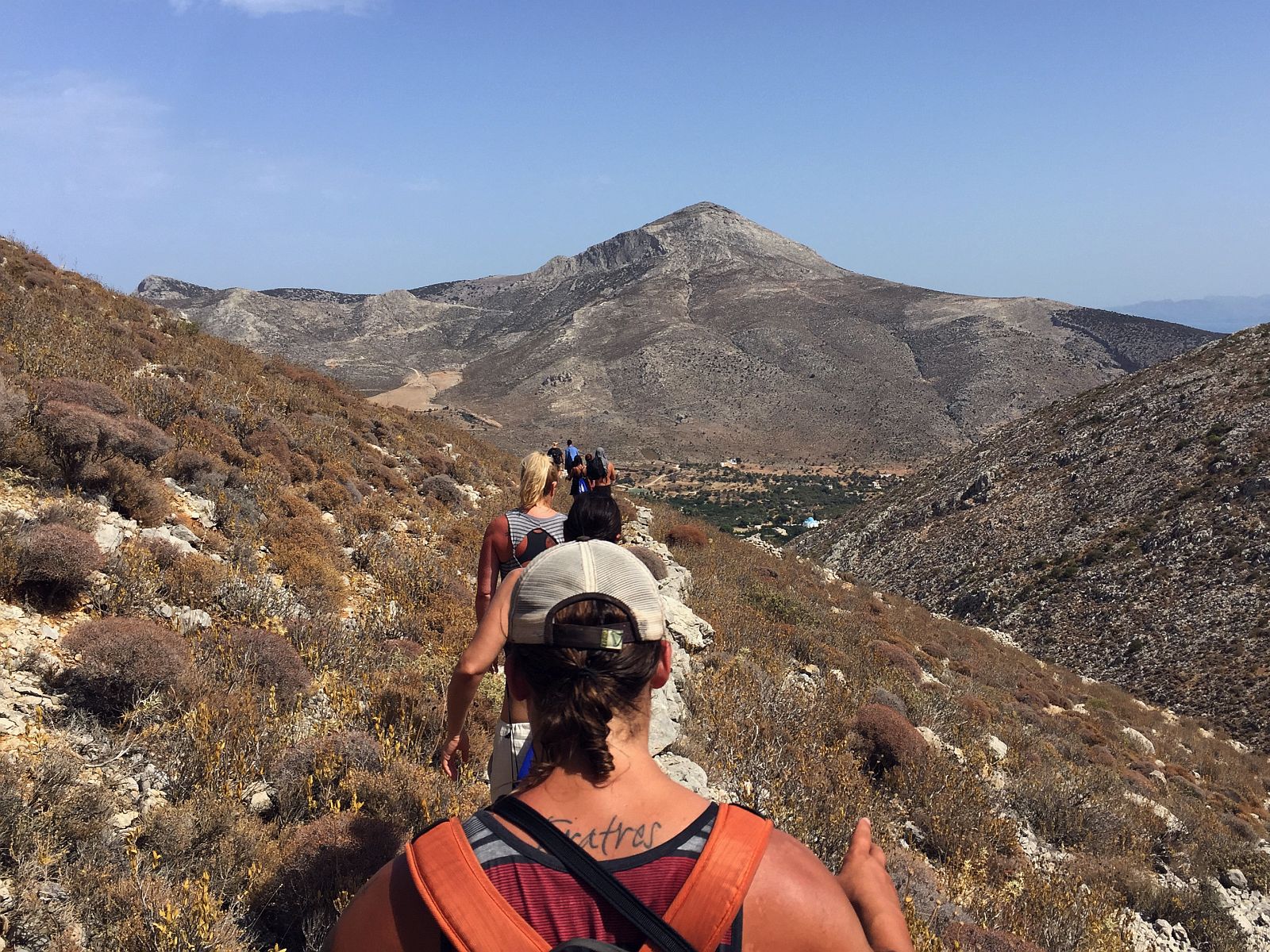
As soon as we pulled into port in Kalymnos, it was clear what the island is known for. All around town were signs heralding the arrival of the Kalymnos Climbing Festival in October, the logo depicting a climber hanging by one hand from the side of a cliff. With its many limestone cliff walls jutting out from the water, and with over 2,500 routes mapped out across the island, Kalymnos is known the world over as one of the best places in the world for sport climbing.
We were not here to climb, but instead to embark on the longest hike of the trip, the Italian Path, a 4-hour trek up and over a large ridge separating the town of Kalimnos from Vathis located on the opposite side of the peninsula. After breakfast, we set out along the marina, making our way past the many small charter boats and wooden crates full of natural sea sponges being peddled by hawkers, a commodity that has been collected and sold here for centuries.
The path’s name comes from the Italians who occupied the island from 1912 up until World War II, and who built the cobbled road to connect the two towns, otherwise inaccessible to each other except by boat. The path winds its way up a narrow hillside, then straightens out and plunges forward until you reach the crest of the ridge, with the southern half of the island splayed out below. With the sun beating down on us and the highest vegetation along the parched path reaching ankle-high, the group settled into a slow crawl forward. For fun (at least for me), I took out my phone and began streaming the theme to Lawrence of Arabia as we marched through the stifling heat.
After reaching the top, the path winds back down into a peaceful valley where olive orchards dot the landscape, then ends abruptly at the end of a long, dusty road. To get to the center of town, you have to continue on for at least another half-hour along a paved street.
Lucky for us, we were able to skip that leg of the hike. Exhausted and tired from our climb, our local guide for the day called a contact of hers, and a few minutes later a flatbed truck with a caged back, presumably for livestock, arrived driven by a large Greek man with a cigarette hanging from his lips. He herded us one-by-one into the back and drove us into town. When we pulled into the main square, the driver opened the back gate and I jumped out, feigning gratitude and kissing the ground, a confusing site for the dozens of tourists eating lunch there.
After our own lunch of grilled squid, a local specialty, we returned back to the boat, changed into our bathing suits, and spent the rest of the afternoon splashing about in the cool, refreshing bay’s water and watching the many climbers scale the cliffs above us, testing their skills in what may be some of the most picturesque climbs in the world.
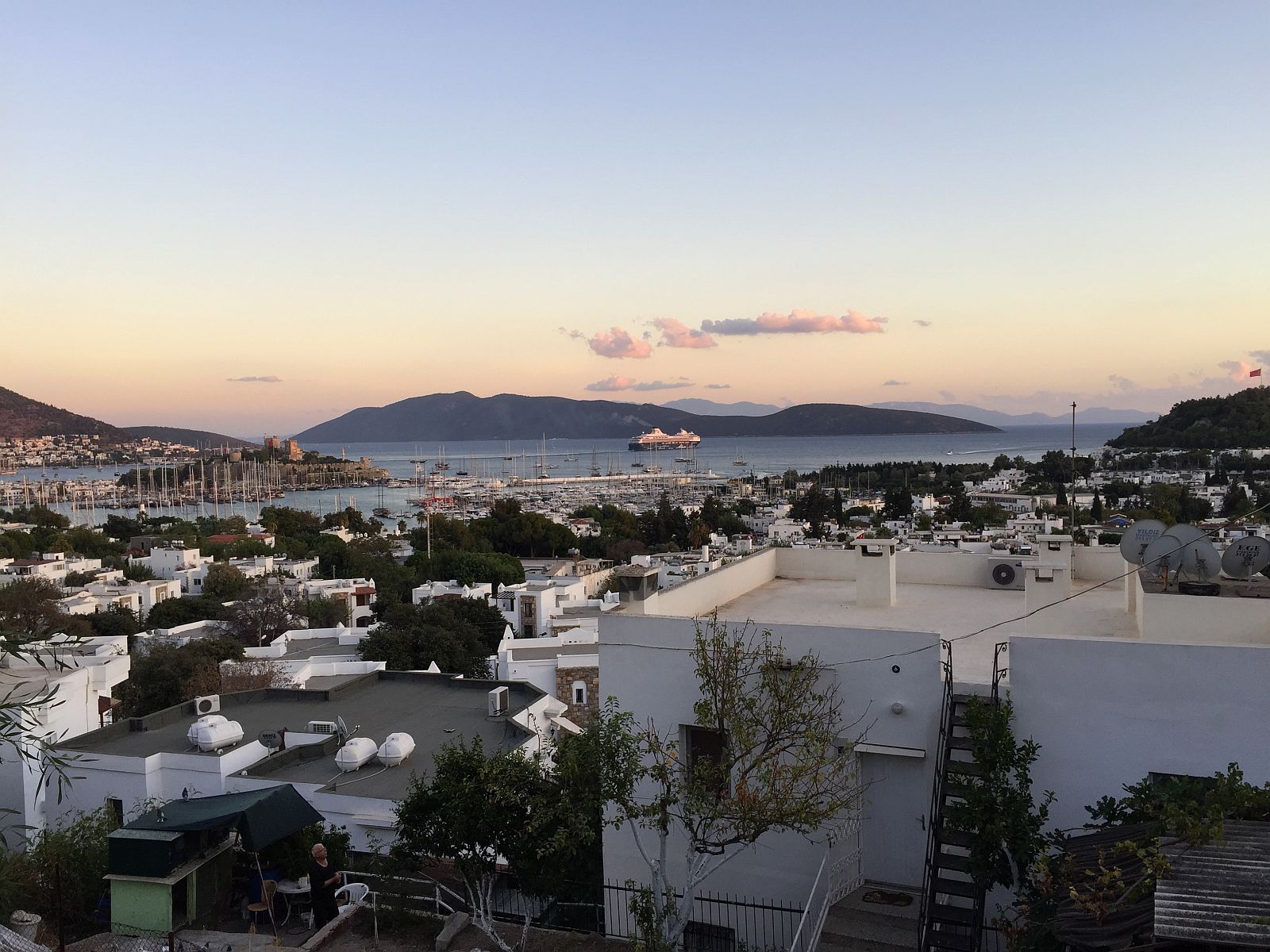
We woke up in the morning to the sound of the boat’s engines firing up. We had spent the muggy night outside on the top deck, falling asleep to the low din of the dockside clubs and to the sight of a night sky impossibly filled with clusters of stars.
Our next-to-last stop before arriving back at Kos was Bodrum, the port city on the Turkish coastline. Located on a peninsula jutting out in the Aegean sea, the town is a well-known vacation hot-spot for both the Turkish and European elite. It was also an Ancient Greek city with a fabled history (it was home to one of the Ancient Wonders of the World, the Mausoleum of Mausolus).
With an afternoon to spare, we decided to visit Bodrum Castle, the city’s most famous attraction. Built in 1402 by the Knights of St John, today the castle is home to the Museum of Underwater Archaeology, a collection of relics that have survived the centuries of invasion, earthquake, fires and human development that has frequented this part of the world since the dawn of civilization. On display in the castle’s many rooms you can find Egyptian jewelry, ancient Greek pottery and assorted coinage all coming from shipwrecks dating back to the 12th Century B.C.
Afterward, we took a stroll through the winding streets of the bazaar in the center of town, then sat at a second-story cafe, sipping apple tea while watching the many visitors in town walking through the marina.
In time for dinner, we met the group back on the boat for one of our last meals on deck. We had plans that evening to head out with everyone for hooka and to check out the many beachside bars. Sitting down around our wood table, Cynthia, the owner of Sun Fun You who had recently joined up with us, told stories with the boat’s crew as we drained the remaining bottle of wine on board.
She talked of the boat’s short history: how proposals had been made, babies conceived, and lifelong friendships created all in the short amount of time the boat had been plying these same waters where others have been voyaging for thousands of year. We lifted our glasses for a final group cheers, one last celebration here on our home away from home, out on the Mediterranean.

/
 Matt Stabile is based in New York City, and is the founder and Editor-in-Chief of The Expeditioner which was founded in 2008. You can read his writings, watch his travel videos or contact him via email at any time at TheExpeditioner.com.
Matt Stabile is based in New York City, and is the founder and Editor-in-Chief of The Expeditioner which was founded in 2008. You can read his writings, watch his travel videos or contact him via email at any time at TheExpeditioner.com.
